CHAPTER VI
RESURGENCE
1940 – 1960
The organization of the Kiwanis Club and the advent of J. R. Cianchette as an influential figure in local and state affairs combined to make the next two decades colorful and exciting. It is impossible to deal with the events of that period without dealing with Joe Cianchette. He not only dominated the industrial life of Pittsfield, but he made his influence felt throughout the state as he extended his vast financial interests into every county. His boundless energy, his daring to try the seemingly impossible, and his dogged perseverance to see a project through were some of the characteristics that brought him to the top of the construction business in New England. No citizen was ever more proud of his home town than Joe. He was continually singing its praises, searching for new industries, and inviting outside business interests to investigate its potentialities. He was Pittsfield’s greatest salesman, and the Kiwanis was ideally suited to assist him in his efforts to revitalize our economy. It was a great combination and it worked!
PITTSFIELD MUNICIPAL AIRPORT
For example, the 40’s had hardly gotten underway when the Federal Government began to take an interest in building airports. We were not at war, but we were on the brink. Already plans were on the drawing boards for air bases scattered over our strategically located state, and in those plans Pittsfield came under consideration, not so much because it could be used as an auxiliary field, but rather because it was already on the official air map of Maine from the days of the 30s when it was started as a WPA project. Cianchette, who at this time was very close to this phase of the construction business, had discussed our location with Mr. Crowell, head of the WPA in Maine, and also brought the matter to the attention of the Kiwanis Club. A committee was appointed consisting of Albert McMichael, J. R. Cianchette, S. M.Cook, Charles Peterson and W. W. Lehr, Sr.
The McMichael brothers surveyed the old airport and land adjacent to it and in October of 1940, final plans were submitted to Washington through the Portland office of the WPA. The plans were
129
approved, providing the town would raise $6,000 for the project. Looking back, it is difficult to understand why there was any hesitancy on the part of the town since the government had allocated $140,000 as its initial grant, yet there was considerable opposition. It was at this point that the Kiwanis did a splendid job of pointing out the benefits to be derived from the development of a municipal airport, and at a special town meeting in February 1941, a favorable vote was obtained. By the end of May, work on the runways had started with a crew of between 40 and 80 local men under the supervision of William L. Myers of Brunswick. As work progressed, another $100,000 was allotted and the runways extended from 3500 to 4500. Before the work was completed, war had been declared and nearly $500,000 had been appropriated to give Pittsfield one of the finest small landing fields in the state.
As a result of this farsightedness, the navy took over the field in 1943 under a CAA war training service. For the duration of the war hundreds of cadets received their initial flight training in Pittsfield, billeting on the M. C. I. campus. This program was operated for the navy by the Portland Flying School, Portland Junior College, and Maine Central Institute. It not only was a factor in our economy, but it offered a splendid opportunity for the town and M. C. I. to make an important contribution to the war effort.
WAR ACTIVITIES
Following Pearl Harbor, Pittsfield, along with other communities, plunged into the serious business of winning the war. The first efforts were in the direction of preparing for the eventuality of an air attack. A Civil Defense unit was organized. Fire Chief Herbert Davis issued instructions to be followed in event of fires; first aid classes were begun under the direction of Kilborn Merrill and William Griffin; Mrs. Ted Cunningham, Clerk of the Rationing Board, published regularly pertinent procedural information; blackout regulations were announced; and a Home Guard was established under the direction of Lyle McCrillis and trained by Captain Mike Broderick and 1st Lieut. James York. The Platoon was drilled on the M. C. I. campus. William Springer was appointed Coordinator.
In January 1943, The Advertiser published the following list of ladies who had offered their services to the Rationing Board:
130
Florence Ames, Abbie Bussell, Vera Brown, Barbara Call, Floraine Cornforth, Ina Fuller, Victoria Hamilton, Dorothy Haseltine, Gertrude Humphrey, Caro Jones, Lena Marsh, Ella Murch, Mildred Nickerson, Margaret Purinton, Dorothy Pushor, Minnie Porter, Helen Shorey, Esther Smiley, Doris Springer, and Marion Stewart.
The nearness of Pittsfield to the huge Dow Airbase in Bangor placed us within a danger zone, according to war officials, and a call was issued by Horace Buxton, Chief Observer, for volunteers for an observation post, which at first was in the tower of the Lancey House and later in an observation tower at the airport. Fifty-four citizens responded and served for the duration of the emergency.
The Advertiser did an excellent job of keeping the home folks informed. Each week letters from men and women in the armed forces were published, promotions and interesting incidents of army life were featured, and an Honor Roll was printed and kept current.
As in all wars fought on foreign soil, the home front suffered least. Each wanted to do his part, sharing in the rationing, Red Cross activities, bond drives, and other related activities, but it all seemed such a meager contribution. Underlying it all was a tension that fluctuated with the tone of the war news. However, it all evaporated in a joyous and spontaneous celebration in August of 45 when the news of the Japanese surrender flashed over the air. Headed by the fire fighting equipment, cars, bicycles, and every other means of conveyance appeared to join in an impromptu parade. Amid mill whistles, screaming sirens, and honking horns, a crowd of shouting, dancing, uninhibited citizens of all ages followed the firemen to the mall on Railroad Street where a huge bonfire climaxed the celebration. The next day Roy Wright was studying the ashes of that fire and came to the conclusion that his dump truck had contributed to the blaze.Oh, well, I guess it was worth it! muttered Roy, a true philosopher.
INDUSTRIAL ACTIVITY
SHOE MANUFACTURING COMES TO PITTSFIELD
In April of 1941, Clyde Martin wrote a letter to The Advertiser asking, Why don’t we do something about the Waverley Mill? This was by no means a new problem. The mill, as we have seen, had lain in idleness for more than twelve years. It was then
131
owned by Willard Cummings who was using it for storage. In one area the roof was about ready to go, and in the main mill some of the floor timbers were weakening. It had reached the point where it was deteriorating rapidly.
One evening in August following a Kiwanis meeting, five men remained to chat about things in general and the question of the Waverley Mill came up. Joe Cianchette suggested that the five men buy it, if the price was not too high, and then he would try to find a tenant. It was done. The water rights were sold to the town and the mill repaired for occupancy. Cianchette was as good as his word, and in September of 1943 he was able to bring the good news that the plant had been sold to Pinchos Medwed of Bangor, a shoe manufacturer. Mr. Medwed did not move to Pittsfield until late 1945, but then he immediately started a training program and by 1948 around three hundred workers were on the payroll. It was a real lift to the economy of the town and most gratifying to J. R. Cianchette, Earle E. Friend, W. W. Lehr, Sr., H. L. Goodrich, and S. M. Cook who had met in the Lancey House one August evening following a Kiwanis meeting.
Mr. Medwed did not remain in Pittsfield very long. In 1950, he sold out to the Northeast Shoe Company which has operated the plant most successfully ever since. To quote from an article in The Advertiser of June 24, 1965, the following paragraph pretty much tells the story: “From a modest start, an employment complement of less than 150 people who produced about 1200 pair of shoes per day, Northeast has grown in the past 15 years to be the largest single employer in this community. Its current working force exceeds 450 people and it is anticipated that the annual payroll for 1965 will exceed one million five hundred thousand dollars ($1,500,000).”
PITTSFIELD WOOLEN YARNS CO., INC.
The Pittsfield Woolen Yarns Co., Inc., which today is an important factor in our economy, had its beginning in the early 40s. Perley A. Wright came to Pittsfield from Detroit where he had operated a general store and during his first years here was engaged in several businesses. At one time he ran a restaurant and bakery in the Elias block and at another time he was in the coal business. Finally, he set
132
up a hand knitting mill in what is now the Howard Fernald building on Park Street. He was in this business when in February of 1945 the Earl Hodgkins’s mill on Sebasticook Street was destroyed in a tragic fire that took the lives of Arlene Emery, Blanche Hunter, and Florence Small. Mr. Wright, who now owned mill property on Central Street, arranged for Mr. Hodgkins to set up a factory and manufacture woolens for the Pittsfield Hand Knitting Company. This arrangement lasted until 1947 when Mr. Wright bought out the Hodgkins’ interest and the Pittsfield Woolen Yarns Co., Inc., was organized and has operated successfully for nearly twenty years. Today the ownership of the company is in the hands of three sons, Clifford Wright, President and Treasurer; Neil Wright, Vice President; and Carl Wright, Clerk. In addition to providing a welcome payroll, the company has been able to offer employment to many who once were with the American Woolen Company but were laid off when the Pioneer was closed down. It has been a fine industry and much appreciated by the townspeople.
MACHINE SHOPS
Guy Huff, a skilled machinist, for a number of years operated a small machine shop at his home on Manson Street. During World War II he was called upon to do work for some of the larger shops, particularly Fay and Scott of Dexter, and as business increased the Manson Street location became inadequate. In the mid40s he designed and built a good-sized shop on Stinson Avenue which he operated until he retired in 1959 and sold the plant to Cianbro Manufacturing Corporation, a subsidiary of Cianchette Bros., Inc. Cianbro soon outgrew the building and moved into a larger shop on Hunnewell Avenue to become a part of the Cianchette Bros., Inc., complex. The original Huff building on Stinson Avenue was sold to M. C. I. and is now used as a music center.
Another machine shop to come into being during this period was that of Delbert E. Knowles on upper North Main Street. In 1951, in addition to the routine jobs, Knowles became distributor and manufacturer of the Bunnell Pulpwood Loaders and was kept busy supplying the Maine and Eastern Canada markets. In 1955, Richard Cole joined the firm and remained a partner until Delbert’s death in 1965. In October of ’65 Cole acquired full ownership.
133
CIANCHETTE BUYS LANCEY HOUSE
In January of 1945, J. R. Cianchette purchased The Lancey House from W. W. Lehr, Sr., who had owned and successfully operated the famous old hotel since 1929. With characteristic enthusiasm, Cianchette immediately began making plans to renovate the establishment from cellar to roof. Many improvements were made, but the most startling changes occurred on the first floor under the supervision of hotel architects from Massachusetts. The lobby, dining area, and bar were completely modernized. The dining room, with its murals depicting Maine seascapes and inland beauty spots, was most attractive and in a very short time its reputation for fine food and delightful atmosphere spread throughout New England. Norrnan Wright, a former resident of Pittsfield, was the first manager under the new ownership. Later Darrell Dunton was promoted to Manager, then came George Pratt, James Murphy, Al Marsano and Lloyd Jamieson.
THE ADVERTISER CHANGES HANDS
Four months after Cianchette purchased the Lancey House he acquired control of The Pittsfield Advertiser from George Huff of Dexter and later that year bought the building that housed the paper. This building, as we have pointed out before, has an interesting history in that it was once part of the Going Hathorn home that was located on what is now Hathorn Park. A study of the pictures indicates that it was once the stable of the Hathorn estate.
Almost immediately, as could be expected, a complete overhauling of the building was underway. A onestory addition was built on the rear, the old wooden floor was taken out and replaced with concrete for the heavy machines, the heating plant was revamped, and a front office added.
Under the Cianchette regime there were a number of editors, all of whom contributed importantly to improving the paper. The first editor was Marshall Hammond and he was followed by Richard Kendall, Ralph Long, Rev. William Willoughby, Rev. Donald Hinckley, Edward Stanley, and Gerald Hackett. Norval Lewis served briefly as interim editor. Rev. Willoughby, Rev. Donald Hinckley and Mr. Stanley served as part time members of the staff.
134
Other officers of the paper were listed as J. R. Cianchette, President; Roy U. Sinclair, Treasurer and Editor; and Irving Whitman, Production Manager.
After nearly two decades of ownership, Mr. Cianchette sold the paper to David Olson who published it for less than a year. Today it is owned by The Pittsfield Publishers, Inc., with Gerald F. Mitchell, Managing Editor.
DRY CLEANING
In 1947, Norman Wright resigned as manager of The Lancey House to take over a dry cleaning establishment that L. Q. Wright, Norman’s brother, had set up on Peltoma Avenue at the entrance to the airport. There seemed to be a need for such a business. The White Star Laundry on Park Street had for years ably serviced the area under the management of the Hansons, but the dry cleaning work was intensively solicited by out of town plants. Wrights Dry Cleaning competed for this business and when Tommy Wright resigned to represent a wholesale packing house, Mrs. Grace Wright took over the proprietorship and operated the plant successfully for ten years until it was sold to the McGowan brothers, the present owners.
As in other businesses, the character of the cleaning industry has changed in recent years and today there are three coin or do-it-yourself cleaning establishments: on Park Street, Pittsfield Laundricoin; on Main Street, Norge Laundry and Cleaning Village; and the Bowl Rite Lanes Laundrymat on South Main Street.
RIVERSIDE MILL
In 1950, L. G. Milliken, who had for a number of years operated a shoddy mill, first at the old Bryant mill on Hunnewell Avenue and then at the Riverside mill, decided to retire and sold the business to J. R. Cianchette, Roy U. Sinclair, and Joseph S. Buker. Mr. Buker, who had been with Milliken, managed the mill for the new company. After a short time Cianchette and Sinclair sold their interests to Lewis Rosenthal of Waterville, and Buker continued to act as part owner and manager. In 1965 Mr. Buker retired and Rosenthal took over the property.
135
PELTOMA ACRES
One of the most ambitious residential building projects ever undertaken in Pittsfield was begun in 1946 and completed in a little more than a year. J. R. Cianchette, who had been instrumental in bringing the Medwed Shoe to Pittsfield, had been approached several times on the matter of housing by Medwed and others who might be interested in locating manufacturing plants in the area. Where can we find homes for our employees, particularly the executive staff, if we come? was a common inquiry. With characteristic earnestness and forcefulness, Joe had responded, You come; you need homes; Ill build em! Well, Medwed came and one day, according to Joe, he mentioned that one of his key men was having difficulty finding a place to live and he reminded Joe of his promise that housing would be no problem. OK, well get busy on it, and that day plans were started to build Peltoma Acres.
It was no simple task. In those days building materials were hard to get, so Joe built a mill on lower Peltoma Avenue where he sawed out most of his lumber. Carpenters were scarce locally and many had to be recruited from long distances. There were dozens of problems to solve and decisions to be made before the job was done, but in May of 1947 open house was held and 48 new homes were put on the market.
Since then much has been done by the owners in the way of additions and landscaping. What was once a hay field, today is a well laid out community of attractive residences.
THE EDWARDS COMPANY
The story of how the Edwards Company happened to come to Pittsfield is one of the most interesting in our entire industrial history. Possibly in making this statement the writers perspective is a bit warped since he was somewhat involved in the negotiations. No doubt, if we could have the details of Going Hathorns efforts to get Robert Dobson to locate in Pittsfield, or the conversations and correspondence that must have gone on at the time the Dobsons sold out to the American Woolen, we would find emotion, even drama, mixed into those transactions; but since we do nothave the records and we do know something of what went on between the time the Pioneer
136
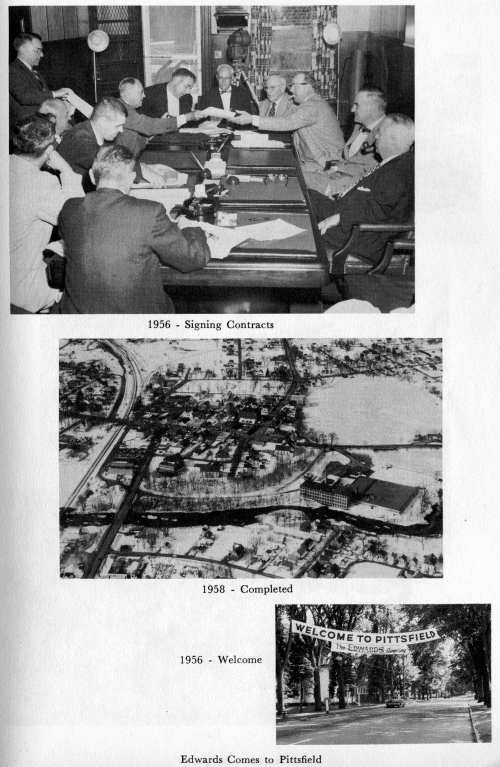
[Page 136.1]
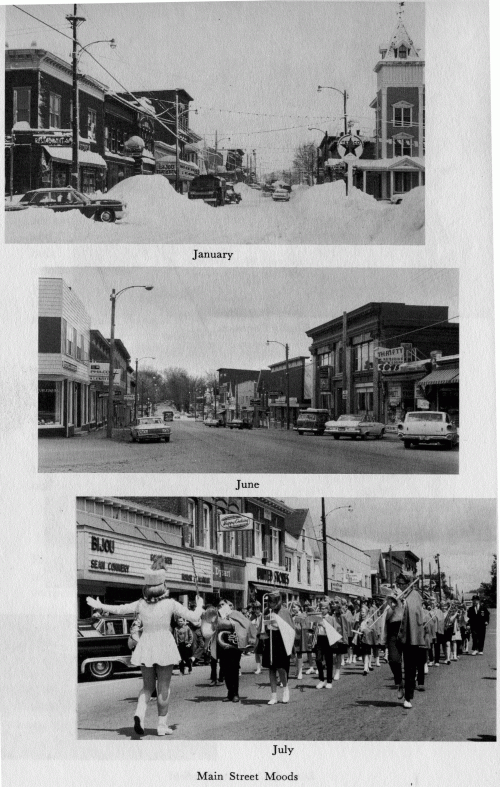
[Page 136.2]
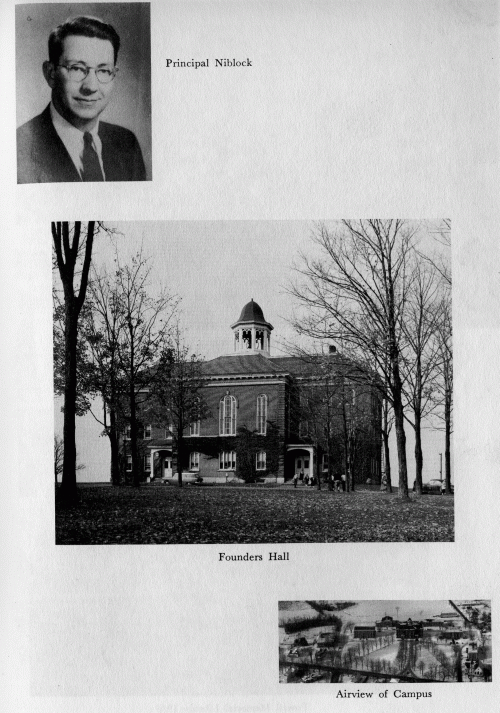
[Page 136.3]
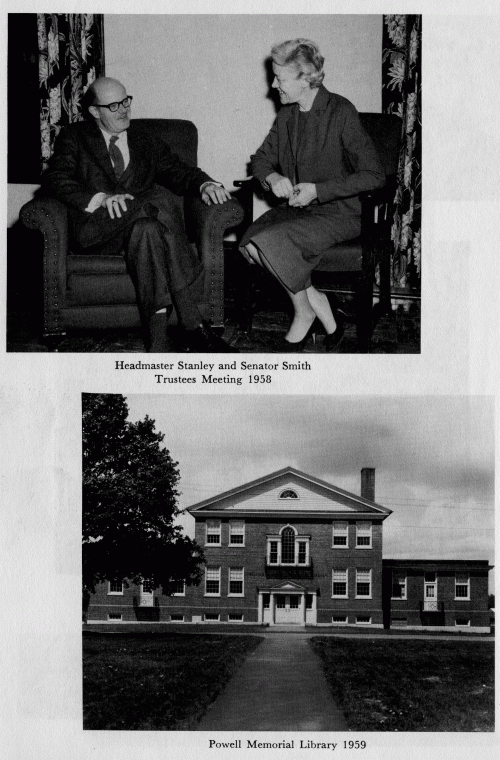
[Page 136.4]
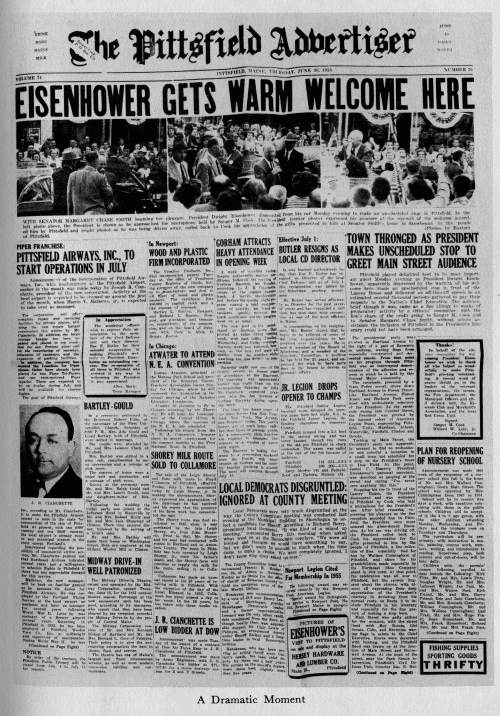
[Page 136.5]
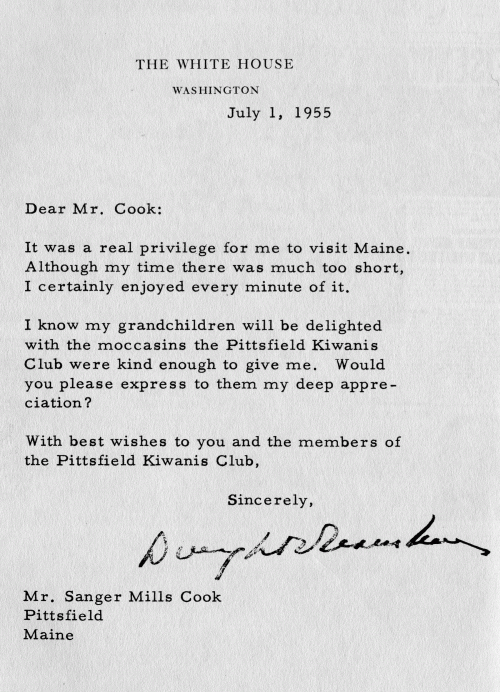
[Page 136.6]
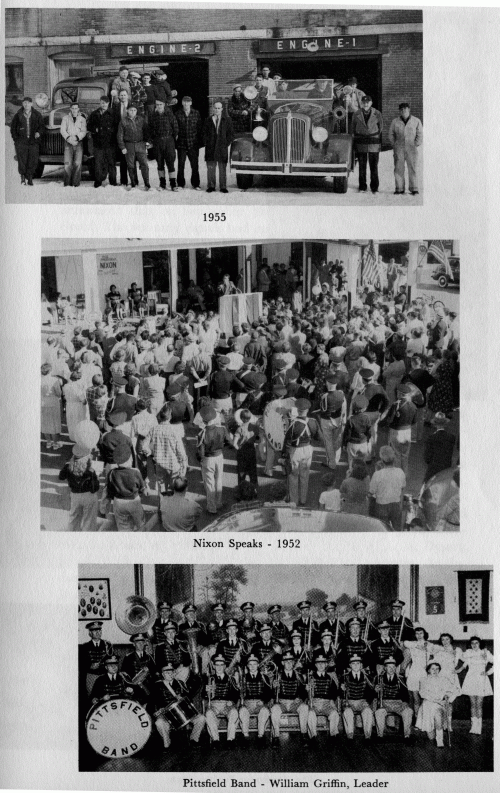
[Page 136.7]
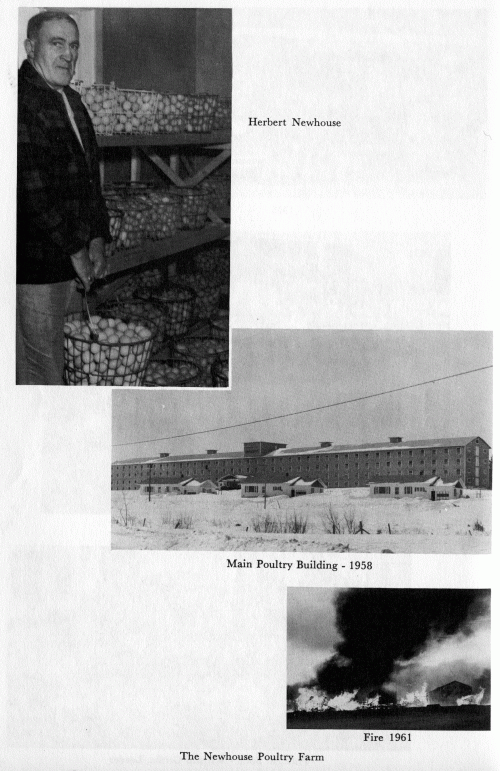
[Page 136.8]
closed and Edwards arrived, we repeat that it is the most interesting story of local industry of which we have any knowledge. It was a dramatic story, filled with discouragement, hope, frustrations, split second timing, and final success. It was a story in which at one point our representatives became involved in a struggle between two giants of American industry for control of a multi-million dollar corporation.
It all started in 1953 when the American Woolen Company announced that on September 19th the old Pioneer mill would be closed. The warning signals had been hoisted the year previous when the president of American Woolen in a speech at a wool convention described the predicament of the industry as grim. In February of 53 feelings were aroused over union contracts. Two local representatives of the TWUACIO were invited to New York to take part in negotiations with management. Although the closing was not unexpected, the final realization of it came as a hard blow to many families that had for years depended upon this particular plant for their livelihood. For a while no one seemed to know what to do.
The first positive action came from the Kiwanis Club. The suggestion was made that a development committee be formed to explore the possibilities of replacing the mill. The Legal Affairs Committee, consisting of Lloyd Stitham, John Furbush, and Harry Coolidge, was asked to form a corporation with authority to raise funds for the purpose of seeking and helping to finance, if necessary, new industry in Pittsfield. On February 1st, 1954 Clair L. Cianchette, who had joined the legal staff of J. R. Cianchette and Sons, prepared the necessary papers for such a corporation and The Pittsfield Development Associates was born. The directors were J. R. Cianchette, Chairman, H. R. Coolidge, George A. Moore, L. A. Dysart, John McMann, Robert Hubbard, and Clair L. Cianchette. An Industrial Committee was appointed with S. M. Cook and W. W. Lehr, Jr., CoChairmen; and R. U. Sinclair, Donald Fendler, and Harry H. Friend.
The first act of the new Corporation was to sell stock to the amount of $50,000. This was no easy task. A committee was chosen to head up the drive, consisting of Roy U. Sinclair, Chairman; Roosevelt T. Susi; Ford Grant; Harry Anderson; and Harry Friend. They did a splendid job and had marvelous cooperation from all members of the
137
Kiwanis Club. In January of 1954, Chairman Sinclair announced that $53,570 had been subscribed by 477 persons.
Now came the work of the corporation. At first the results were most encouraging. Officers of the American Woolen had been appraised of the efforts of the local citizenry and on March 2nd the Associated Press quoted Gordon V. Lyons, Chairman of the Stockholders Fact Finding Committee, as saying the American Woolen management is working out details of a plan to participate with the community in streamlining and modernizing the Pioneer Mills and putting the plant back in operation on a profitable basis. This was wonderful news and was confirmed a day or two later by ExGovernor Joseph B. Ely, General Counsel for the American Woolen, who stated that a plan for establishing a so-called pilot mill of 60 looms was under serious consideration.
This story went over the country and both the American Woolen and Pittsfield came in for much favorable comment. Pittsfield in particular was praised for acting so promptly and so constructively when faced with the loss of its oldest industry. Much credit was given the so-called Ely-Dumaine faction of the American Woolen who believed in New England and that the North could compete with the South if given proper tools, i. e. modern plants and modern machinery. The Pittsfield Plan was commended throughout New England. Everything looked good; hopes were high.
The first inkling that perhaps things were not what they seemed came in August of 54. Five months had gone by and there had been no apparent attempt to activate the plans for a pilot mill. W. Bartlett Cram of the Maine Development Commission met with the local directors and although he was optimistic as to the final outcome, he indicated that there might be some delay because of friction within the official family of the American Woolen. There were hints of a proxy fight for control of the company. This was disturbing but not too serious and would probably be ironed out shortly. We must be patient, was the word.
The proxy fight was serious, however; more serious than anyone believed at the time. Textron was a fast growing holding company under aggressive leadership and was making a deadly serious attempt to gain control of the $26 million textile corporation. Although some of our directors had discussed with representatives of Textron the
138
future of Pittsfield if control of the American Woolen changed hands and had been given assurance that Textron would be sympathetic to the textile problems of New England, there was a distinct feeling that perhaps their interests were more with the South as a locale for manufacturing. The picture began to take on shadows of uncertainty and even gloom. There was little our local directors could do but await the outcome of this struggle for power between the two gigantic financial corporations. Our friends were in the Ely-Dumaine group, we felt, and our hopes were on their ability to survive the proxy battle.
The climax came the day before Christmas. Cianchette was in Aroostook involved in a legal dispute over an airbase contract. Word came to him to be at Ex-Governor Elys office as soon as possible for an important meeting. He got the court to recess, sent his witnesses home, and flew to Boston, accompanied by Harry R. Coolidge, Attorney for the local development association.
The meeting was important to Pittsfield. It turned out to be the key that opened the way for eventual success. Mr. Ely had become convinced that they could not stop the Textron drive for control, and feeling that more concrete assurance should be given to carry out the Pittsfield project as promised, he had drawn up an agreement with the Pittsfield Improvement Association (formerly the Pittsfield Development Associates) committing the American Woolen to spend $250,000 to replace the Pioneer mill with a modern manufacturing plant. Cianchette and Coolidge came home from that meeting on Christmas Eve and it was quite a Christmas package for our town. Within a week following this meeting, Textron had won its battle for control of the American Woolen and in the months to follow most of its properties were sold and its emphasis on textiles was centered in the South.
Although the Ely agreement was honored by Textron interests, it was not until October 25, 1955 that the final papers were signed. Throughout most of that year the project was in a state of unrest. Excerpts from the Waterville Sentinel, October 25, 1955, give some idea of what went on that spring and summer: The validity of the Ely agreement remained intact after the transfer of the textile reins to Textron-American, so the project underwent various stages of planning from a 48,000 to a 125,000 square foot building, and from a
139
proposed pilot plant to a spinning mill, to a half million dollar 96 loom integrated woolen mill to be under Textron management. Although Textron appeared anxious to help justify Pittsfield’s faith in its reincarnation, the town was left to simmer under the heat of uncertainty and trepidation. Directors of the Pittsfield Improvement Association were called into session time after time when company heads appeared to discuss new problems that cropped up.
The final bottleneck came when Textron signified thumbs down on company operation of any type here because of its new policy of diversification.
However, apparently aware of a moral obligation, Textron did not sell the town short.
It agreed to release the mill properties, including the mill proper, outbuildings, mill residences, and water rights in Pittsfield and Hartland for $16,000; to loan PIA sufficient funds for the construction of a 48,000 square foot building for manufacturing purposes; and to assist in the location of a tenant.
Cost of the project is expected to hover around the $300,000 mark.
Textron gave the green light for the construction before cold weather of the mills outside wall foundations, which were started two weeks ago under the supervision of Alonzo Harriman, Auburn Architect.Waterville Sentinel, October 25, 1955.
The next move was to find a tenant. The Industrial Committee contacted W. Bartlett Cram, who had been most helpful throughout the long period of negotiations, and now he went to work in earnest. In an unbelievably short time he uncovered a lead that took him to the Edwards Company, in Norwalk, Connecticut. It is interesting how it came about. Mr. Cram relates that one day at the state capitol he learned from Commissioner Tupper of the Sea and Shore Fisheries, that a man in Boothbay had invented an electronic buzzer and had taken it to the Edwards Company for examination. They could not use it, but had made the remark that they were looking for a new plant for expansion and that some day they might be in a better position to consider new products. Two weeks later Mr. Cram was in Norwalk, caught Mr. Edwards as he was leaving for an out-of-town business trip, was referred to one of the plant officials, and within days brought several representatives of the company to Pittsfield.
140
They were impressed with the town, particularly the schools, the churches, and the spirit of the people. One thing that we could offer that other towns couldn’t, or, at least, didn’t, was that we were in a position to build them a building of their own design. This may offer a lesson to municipalities looking for industries. Rather than erecting a so-called speculative building and then trying to interest a prospect, why isn’t it better to be able to say to that prospect, You have been in business a number of years and must have definite ideas for improving the efficiency of a plant layout. Why not let us build you a factory of your own design? Well furnish the architect; you tell him what you want within the allotted budget, and well build it as you want it. Whether this is good salesmanship or not, it seemed to work in the case of Edwards. Mr. Sharp and other company officials went over the plans many times and followed the construction through the summer and fall of 56 as avidly as did the local committee. It was a mutually pleasant experience.
Before the building was completed, additional capital was required and was obtained through the Maine Development Corporation. By late fall it was ready for occupancy. Ralph Desmond was the first Manager; DeWolfe Finch, Assistant Manager; and John Russell, Maintenance Supervisor. The first buzzer came off the assembly line in December, Representing, said Sylvia Lehr in the Waterville Sentinel, the echo of scores of doorbells rung three years ago by 59 Kiwanians with a conviction.
CHANGES DOWNTOWN
Increased payrolls meant activity in the downtown business area. In 1942, J. R. Cianchette purchased the S. F. Jones block and some adjacent property and erected a two-story building, housing two stores and a barber shop on the street level and several apartments on the second floor. In ’55, Mr. Cianchette located the Pittsfield Truck and Farm on Hunnewell Avenue in a large two-story frame building containing a well laid out display room and service area to represent the International Harvester Company. Harold Crossman was the first manager, who was succeeded by Norman Wright and later by Maurice Earle. While Mr. Earle was manager the business was moved to a location on South Main Street. Further out on the Burnham
141
road, W. W. Lehr had opened a thriving furniture business. In 1947 Burrows and Harris opened a service station at the corner of Main and Grove Streets. Later Mr. Burrows took over the business and eventually became an active dealer in antiques. The same year Lester Stone, an experienced insurance man, purchased an interest in the S. F. Jones Insurance Agency. When Mr. Jones retired, he sold his interest to Stone. Two other changes occurred in 47The White Star Laundry on Park Street was sold, and Wrights Dairy opened a pasteurization plant on Highland Avenue. In 1948, the Thrifty Store came to Pittsfield and Main Street was improved by two new store fronts at L. A. Dysart’s and the United Stores. In 1950, the Parks Brothers Insurance Agency, owned by E. N. Vickery, and the Sanger M. Cook Agency, owned by W. W. Lehr, Jr., merged and operated as Vickery and Lehr, Inc., until 1954 when Mr. Lehr became sole owner. 1950 was the year the Fendler-Tilton Motors occupied the P. E. Susi shop on South Main and took on the Dodge Car Agency; the A & P store moved into the Hanson block at the corner of Main and Hunnewell; and John McMann bought out the Cox gas and fuel oil business at the corner of Main and Park, where the old Hunter-McMaster store was once located. In 1952-53, the L & H Chevrolet Agency was established on South Main and Libby Streets, and in 1955 Adrian Hallee bought out Mr. Lenentine. The company has a body shop on Hunnewell Avenue.
In 1955, The First National Bank did a major renovation job, incorporating into its quarters the space occupied by Spear’s Clothing store. Guy Susi was the architect and J. R. Cianchette, the contractor. It was an excellent move and was admired by hundreds of visitors on opening day. The following year, the New Central from Bangor established a branch store at Farrar’s Furniture on Park Street with Ralph Morton as Manager. In 1957, J. R. Cianchette and Sons, Inc., erected a tremendous office and repair shop on lower South Main. On the same property and a part of the Cianchette enterprises was a smaller warehouse, a building housing the International Harvester agency, and a modern service stationall surrounded by acres of hot top paving to make it one of the finest establishments of its kind in the state.
This was the year Cianchette took over the Bijou Theatreand did another one of his imaginative remodeling jobs. A new marquee
142
opened into a beautifully decorated lobby that led to a large auditorium with sloping, carpeted floor, cushioned rocking chair seats, a spacious stage with cinemascope screen. The theatre was air conditioned and equipped with the finest sound and movie projectors. It was an important addition to Main Street and proved to be most popular.
In 1959, after Mr. Cianchette had moved his Truck and Farm business to South Main, he demolished the old frame building on Hunnewell Avenue and erected a very attractive and well planned one-story brick block to house Buds Supermarket. To make it one of the most desirable shopping centers in this area, he also provided a large paved parking area.
EDUCATION
The schools shared in the prosperity of this era. The buoyant spirit of the times was contagious and caught hold of our educational leaders. A school lunch program was inaugurated, and by 48, 25,000 meals were served annually. At this time the Grammar School was becoming crowded and the School Committee recommended a four-room addition. The recommendation was adopted and J. R. Cianchette contracted to do the work.
MANSON PARK SCHOOL
In 1951, the PTA became a factor in school policy. Lester Stone who was a candidate for the School Board, was active in promoting a survey of the school system which resulted in a report that declared the Hartland Avenue School hazardous, the Grammar School inadequate, and the Riverside unfit for school purposes. The report drew applause and criticism. A citizens committee composed of Rev. Donald Hinckley, Nelson Lane, Harold Crawford, Guy Susi, Walter Jacobs, Bernard Nichols, Seymour Burch and Clifford Wright in a rebuttal stated that these school buildings were not as terrible as pictured and without much expense could be repaired and made suitable. At the town meeting in March, the PTA report was rejected. In May the PTA again sought funds for a building program. L. A. Dysart was prominent in this movement. A special meeting was called in June to consider the matter and the proponents were shut off
143
arbitrarily by a motion to adjourn. This type of procedure backfired on the opponents for there was considerable resentment afterwards and increased sympathy for the proposed school program. At the next annual meeting in 1952, $75,000 was recommended for a new elementary school and in December of that year the Manson Park School was ready for occupancy.
VICKERY SCHOOL
In 1955 and 56 there was considerable agitation for a new Grammar School. In the eight years since the addition to the old Grammar School, school population had increased rapidly and again teachers were faced with overcrowded classrooms. Clair Cianchette took the lead in advocating a new $200,000 building, located north of Somerset Avenue. As in the past, opposition quickly developed, first, to the idea of spending so much money, and, second, to the location. Strange to say, not many questioned the need for more classroom space. After several meetings, some of which were rather emotional, the voters approved an appropriation of $200,000 and a one-story cloverleaf style of building was designed by architect Maurice E. Witmer and the contract let to H & K Foster of Wilton, the same firm that built the Edwards plant. The school was named in honor of Earl N. Vickery, who had served faithfully on the local school board for years and had taken an important role in shaping educational policy in the state. Open house was held in October 1958.
The Vickery School relieved the pressure on other elementary schools and made it possible to dispose of Riverside School in 1959. The building was sold to C. Almy and Sons, manufacturers of church goods.
MAINE CENTRAL INSTITUTE
M. C. I. had a remarkable growth during these years. Some of the highlights of the period included the acquisition of the Manson House, which served as the Headmaster’s home; the Industrial Arts building, which was obtained from Quoddy; the Nye property, temporarily used for a music center; the Cianchette Hall of Science, made possible through the generosity of J. R. Cianchette and a $50,000 appropriation by the town of Pittsfield; and the Powell Library, a
144
bequest of Mrs. William H. Powell in memory of her husband, Judge Powell, of the class of 85.
The Cianchette Hall of Science and the Powell Library combined to give M. C. I. one of the finest educational facilities in New England preparatory school circles. The first floor of the science building provided space for the Biology and Home Economics departments; the second floor contained spacious chemistry and physics classrooms with adjacent laboratories and an audiovisual auditorium.
The Powell gift proved to be the most generous in the history of the school. It provided funds not only for a well built, well equipped, and beautifully appointed library, but it also allowed space for several much needed classrooms. In addition, there were funds for a modest endowment.
There were three Principals and one Acting Principal between 1940 and 1960. After a most successful administration, Mr. Purinton resigned to accept a position as head of the State School for Boys at South Portland. Until a replacement was chosen, Howard Washburn acted as Principal. In 1946 Howard Niblock, a Bowdoin graduate, who had been a member of the faculty at Mt. Hermon School, was elected Principal. Mr. Niblock proved to be a popular administrator during his tenure of ten years. In 1956 he resigned and Edward Stanley was elected. The choice of Mr. Stanley was unique in that his entire teaching experience had been in the service of M. C. I. He came to the school in 1939, a young graduate of Bates College, and until he was called into the service in World War II, he was an instructor in the history department. After the war, he returned to the campus, taught history and English, coached debate, and then was named Alumni Secretary. With this background, he was able to accept the principalship with a better understanding of its responsibilities than most of his predecessors. He has fulfilled the confidence the Trustees placed in him and under his leadership the school has prospered and grown in prestige.
Early in Mr. Stanleys administration he made two important appointments. John Shields, an Amherst graduate, came to M. C. I. with Mr. Stanley in 1939 and later taught outside the state. He returned to M. C. I. in 1956 to become Dean of Boys and Guidance Director. He has been an able assistant in handling administrative details of the school. Mrs. Roy Sinclair, a graduate of the University
145
of Maine and a former member of the faculty, was asked to return as Dean of Girls. It was a fine choice as she has proved to be an understanding counselor in addition to serving as head of the Home Economics department.
In a private school the director of alumni activities is an important post and when Mr. Stanley became Principal, his position of Alumni Secretary was filled by Mr. Dana Sweet, who has carried on the work of that office expeditiously.
Throughout the two decades M. C. I. offered an active and stimulating undergraduate program. There were curricular changes that broadened the elective studies and at the same time placed greater emphasis on basic courses—particularly in the English and science divisions.
Extracurricular activities included music, drama, public speaking, literary club work and athletics. In competitive athletics M. C. I. was continually making the headlines. Under Legge, Corey and Wiggin in football; Smith in baseball and later soccer; Earle and Young in crews country and track; and Pratt and Dana in basketball, state championships became a habit. Several times the basketball teams went to Massachusetts to compete for the New England title and in 1958 under Mr. Dana the team came back to Pittsfield with the coveted trophy. In recent years there has been a wider participation in athletics as a result of a policy of diversification. In most of the boys’ sports there are now both undergraduate and post graduate schedules, while new activities have been added such as soccer, tennis, golf, skiing, rifle, and outing club projects. The girls under the coaching of Mrs. Russell take part in field hockey, basketball, track and Softball. In addition to all this, a physical education program and a schedule of intramural sports make it possible for all students to take part in some form of exercise, competitive or otherwise, unless excused for medical reasons.
CHURCHES
FIRST BAPTIST CHURCH
The religious denominations shared in the resurgent spirit of these years. The dynamic Rev. Henry Osgood was serving as pastor of the First Baptist Church as the 40s opened. He was followed by
146
Rev. Sterling Helmer (19431948), Rev. Stephen Johnston (19481954), and Rev. Bruce Cummings (19541959). During Mr. Cummings’ pastorate the 100th anniversary of the church was celebrated in 1955 and a Sunday School annex was built and dedicated in 1958 in honor of Mrs. Ralph L. Cianchette who had served for 25 years as Superintendent of the Sunday School.
UNIVERSALIST CHURCH
The deaths of Rev. Milo G. Folsom in 39 and the Rev. Josephine Folsom in 46 were sad occasions for the Universalists. The Folsoms had made a very great contribution to the church and the community. Following Mrs. Folsoms passing, Rev. Donald Hinckley, a young personable minister, was called to serve the parish for the next ten years. Rev. Hinckley resigned in 1956 and Rev. Robert Fiske, a Seminary student, occupied the pulpit until 1958. It was during Rev. Fiskes tenure that the property of the church underwent a major change. During the Folsoms ministry the old Lancey Homestead had been purchased by an anonymous benefactor and given the parish for a parsonage. It was now sold to a major oil company for a service station and a new parsonage was acquired on the corner of North Lancey and Easy streets adjacent to the Grammar School. It had previously been the residence of Mr. and Mrs. Andrew Younger. This transfer provided funds for repairing and redecorating the church building. The project was under the supervision of J. R. Cianchette and once again the property was restored to its original beauty. At the 91st anniversary of the church it was observed that there had been three milestones in its historyit was organized in 1867, rebuilt in 1899, and renovated in 1958.
Rev. Fiske resigned in February of 58 and in June Rev. Scott Kitteredge, who had just graduated from the Bangor Theological Seminary, accepted the pastorate. Rev. Kittredges ministry proved to be a hectic one. In one sense he was a victim of circumstances. He arrived at the moment in church history when the Unitarian and Universalist denominations were about to merge. The move had been under serious consideration for a number of years and, although the final vote on the national level was fairly conclusive, a number of local parishes hesitated to join the movement. The Pittsfield church was in this category.
147
When the question came before the Parish for declaring its position, the vote was not to merge. A committee was then chosen to study what action should next be taken. After nearly a year of earnest consideration, during which the heads of leading denominations appeared before the committee, it was voted to recommend that the Parish affiliate with the Congregational organization. The Parish accepted the committees recommendation and for a few months carried on within the Congregational community.
As one would expect in a situation of this kind, there were disappointments and from those disappointments frictions developed. A second meeting of the parish was called and it was voted to rescind its former vote and to return to the Universalist faith. The result of this decision was unfortunate since there were those who could not be reconciled to giving up their Congregational affiliations and resigned from the parish to organize a church of their own. The record of that effort will be recalled in the following chapter.
ST. AGNES CHURCH
These twenty years were kind to St. Agnes Parish. The beloved Rev. Leo Carey, who had replaced Fr. Ballou in 1928, was the local priest when the era opened. At that time there were less than 40 families. Father Girardin recalls in his excellent resume of Parish history that 1928 was the year that the Dr. Blanchard house at No. 1 North Main Street was purchased and served as the rectory until 1962 when the church was blessed with a new rectory. It is also stated in 1947 that some land has been purchased, a part of which one day will be used for a rectory next to the Church and the rest will be made into a much needed parking space.
Quoting further from Father Girardins historical sketch:
Fr. Leo Carey, beloved by all, was transferred to Dover-Foxcroft where he died a short time later. Fr. Edward Lynch came from Damariscotta and took possession of St. Agnes Parish, on September 28, 1948. For ten years, Fr. Lynch, now pastor of St. Athanasius Church in Rumford, labored in the parish and organized societies. He put the parish on a sound financial basis.
In 1958 Fr. Samuel Dougan came from Mars Hill in February, and became the third pastor of Pittsfield. In a very short time he gained the love and respect of everyone. A parish hall was added to
148
the property during his stewardship; the Knights of Columbus were organized and much work done on the parish properties.
On May 1, 1960 Fr. Dougan was transferred to Hallowell and Fr. Antonio M. Girardin was appointed pastor or St. Agnes in Pittsfield.
Father Girardins stewardship will be described in the following chapter. When he took over the parish, it had grown to nearly 200 families.
CHURCH OF THE NAZARENE
I am indebted to Mrs. Carl Emery for the following facts relating to the Church of the Nazarene, which in its comparatively brief years of ministry has established itself as one of our most valuable denominations. In 1949 these dedicated people purchased the Leon Moody property at the corner of Somerset Avenue and Forest Street and for ten years worshipped within the walls of this home which had undergone considerable renovation. In 1959 a church edifice was erected on the property, most of the labor being furnished by members of the congregation. It was dedicated in 1960. Carl Emery served as Chairman of the parish and Mrs. Emery acted as Treasurer.
The first pastor was Rev. Ransford Webb who was followed by Rev. Paul Neal. Rev. Ray Blachly and then Rev. Harley E. Bye are remembered as two very able pastors who were succeeded by the present minister, Rev. Zaven Donhanian.
CALVARY BAPTIST CHURCH
The Calvary Baptist church was organized February 11, 1952 and affiliated with the Conservative Baptist in 1955. In 1954 they purchased the building which they now occupy on Park Street and converted the first floor into a very serviceable place of worship. Under the leadership of Rev. John Boone from 1952 to 1958, the denomination experienced a vigorous growth which has continued during the pastorate of Rev. Charles Mason. During 1958 and 59 the church provided a home for the newly organized Christian School, Inc., which later moved to a spacious campus on the outskirts of Rockland. The Rev. Harold Duff, with the cooperation of state leaders in the denomination, was an inspirational leader in this movement.
149
Today further expansion is planned for the local church on property that has recently been purchased on Grove Hill—property that the Episcopal group once planned to use for church premises.
SPECIAL EVENTS
Many special events occurred between the years 1940 and 1960 that should be dealt with in some detail, but within the limits of this brief sketch, it is impossible to do more than to mention a few of the highlights. In the early 40s, George Roundy, a colorful proprietor of a barber shop, a racing fan, and an ardent Legionnaire, headed a movement to improve the Legion Hall on Manson Street. As a result of his enthusiasm, a new heating plant was installed and the hall and dining area were redecorated. J. R. Cianchette contributed substantially to this project. In 42 a sensational bank embezzlement involving more than a $100,000 made the headlines. In 1952 another headline shocker went over the country when five members of the local clergy charged immorality in our fair town. One news release quoted one of the Reverend gentlemen as stating that the only difference between Pittsfield and Hell was that in Pittsfield there was no river Styx! However, the accusations were not taken too seriously and were soon forgotten. In 1951 the Waverley Bridge was rebuilt and dedicated to the memory of the Pittsfield men and women who gave their lives in the Korean Conflict. The names of Capt. Edward Buckley, J. Gerald McMann, and Merlon L. Killam are inscribed on a plaque placed on the bridge.
The realization that Pittsfield was getting old was brought home by three anniversary ceremonies. 1942 marked the 75th year of the Universalist Church; in 1950 the Grange held its 75th celebration; and 1955 was the 100th anniversary year for the Baptist Church. Mr. and Mrs. Maynard Dolloff were guests at the Grange anniversary party. Roland Wiles was Worthy Master and Elizabeth Sobey had charge of the program. Charles R. Ames was the only 50year member present. Others represented by proxy were Etta Libby, Porter Soule, Mrs. Annie Frost, Mrs. Mary Willis, and Mrs. Myra Dyer. Four past masters were present: Harry Dunton, Stanley Goodrich, Leigh Shorey, and Hartlow McLeod.
150
MANSON PARK
In 1947 construction of Manson Park was begun. Six years had elapsed since the death of J. W. Manson who had bequeathed the bulk of his estate to the town of Pittsfield for a park to be named the Mary Ann Lancey Manson Park in memory of his mother. The reason for the delay was to allow five years of interest to accumulate sufficient funds for an architect to draw plans for a long range program and a contractor to do the basic work in grading and outlining the thirty acres that bordered the west banks of the Sebasticook. The committee elected to supervise the initial steps in this project consisted of Florence Buxton, Sanger Cook, Clyde Martin, Sadie McCrillis, and Roy Sinclair. The preliminary work was completed in the spring of 48 and the first program was under the direction of Maurice Earle. 282 young people participated in a schedule of games and exercises at the park and a supplemental swimming program at Sebasticook Lake under the supervision of the Red Cross. Gradual development of the park continued. Driveways, walks, athletic fields, picnic areas, and pools were constructed and complemented by carefully planned landscaping to give Pittsfield a useful and attractive outdoor recreational center. Earl Gordon was hired as Superintendent of Grounds.
SWIMMING POOL
In 1952, while John L. Baxter, Jr., was president of Kiwanis, the need of a swimming pool was brought before the club. The idea grew and a committee was appointed to push the project forward, made up of Francis Saunders, Chairman; Engineer, Guy Susi; Construction, J. R. Cianchette, P. E. Susi; Finances, George Moore, Earle Friend, Herbert Newhouse, John McMann, Sanger Cook; Operation, Kilborn Merrill, William Springer, Harry Coolidge, Hugh Hersey; Public Relations, W. W. Lehr, Jr., Harry Anderson, Roy Sinclair.
In July 1953 the pool was ready for use and was dedicated. Past President Baxter presided at these ceremonies. President Roosevelt Susi, on behalf of the Kiwanis Club, presented the pool to the Trustees of Manson Park, and Florence Buxton, on behalf of the Trustees, accepted. Lloyd H. Stitham, Chairman of the Board of Selectmen, accepted the pool on behalf of the town. A great deal of credit was given the contractors who contributed generously of their time and equipment in the construction.
151
THE EISENHOWER VISIT
One of the outstanding events of this period was the brief visit of President Eisenhower in 1955. Probably never was so much emotion generated in so short a time. The event itself was over in fifteen minutes, but the impact of that friendly gesture on the part of the President will be long remembered by those who witnessed it. The background of the visit may be of some interest.
Several months went into the planning of it. Word had gone out at the beginning of the year that the President might spend a few days in Maine to enjoy a little fishing and relaxation. The writer, who happened to be in Washington that winter, obtained an interview with Sherman Adams, the Presidents Assistant, through the courtesy of Senator Smith. It was verified that such a vacation was being discussed and that there was a possibility that, if it did materialize, the President would at some point be in the vicinity of Pittsfield.
It wasnt until sometime in May that word was received through the office of Senator Smith that the Chief Executive planned a vacation in Maine in the Rangeley area and that he would visit the Senator at her home in Skowhegan on his way to the Dow Airbase where he would leave for Washington. Knowing of our desire to welcome the President in Pittsfield, the Senator prevailed upon the White House to arrange a detour from Route 2 at Ell Hill through our town via Hartland Avenue, Forest Street, Central Street, Main Street, north to Grove Hill and on to Newport and Bangor. It sounds simple, but altering plans in the Presidents itinerary is no easy matter and without Senator Smiths wholehearted cooperation, it would have been impossible.
At this point I will turn the reader over to Sylvia Lehr’s description in the Waterville Sentinel of what followed:
Immediately, Secret Service men made an undisclosed visit here to interview Cook and Town Manager Allen Marks.
After the route was approved by the White House, representatives from the Kiwanis Club, Merchants’ Association, municipal office and service organizations were appointed with Cook and Lehr, who was President of Kiwanis, at its head.
The first thought was given to decorating the town. Harold Fish of Bath was hired to take care of this detail. Merchants cooperated
152
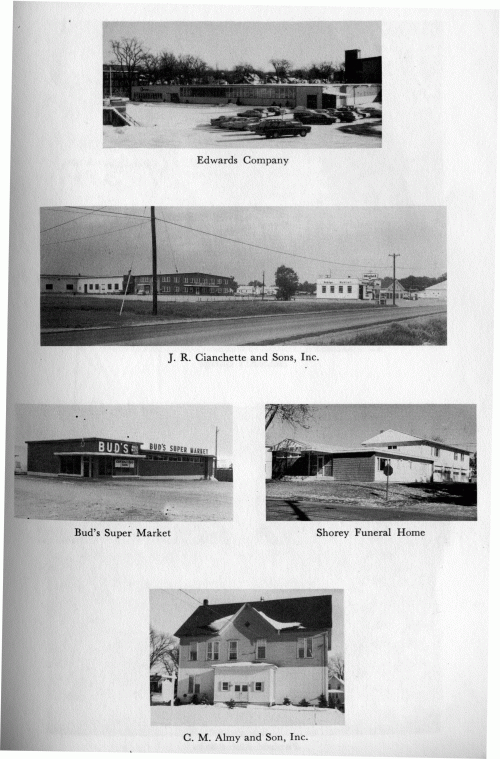
[Page 152.1]
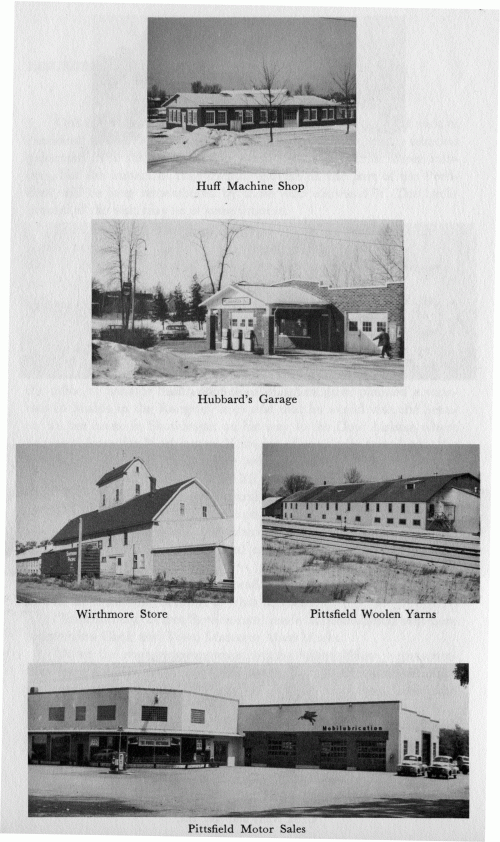
[Page 152.2]
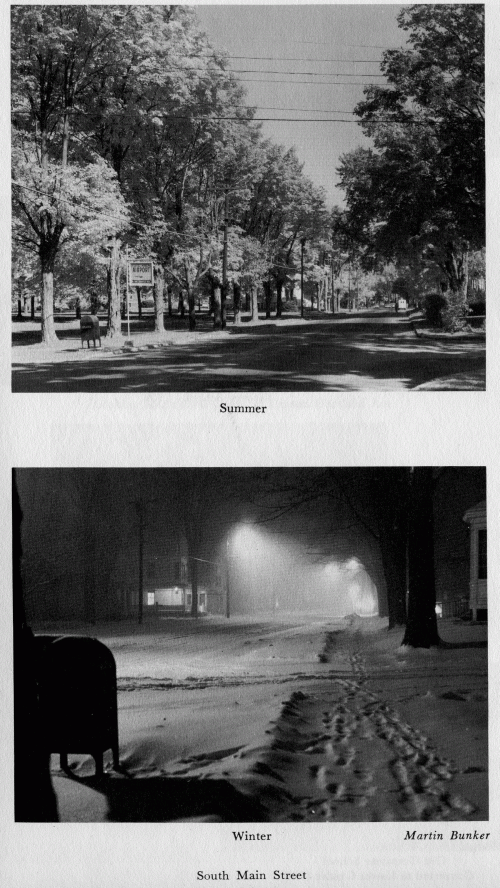
[Page 152.3]
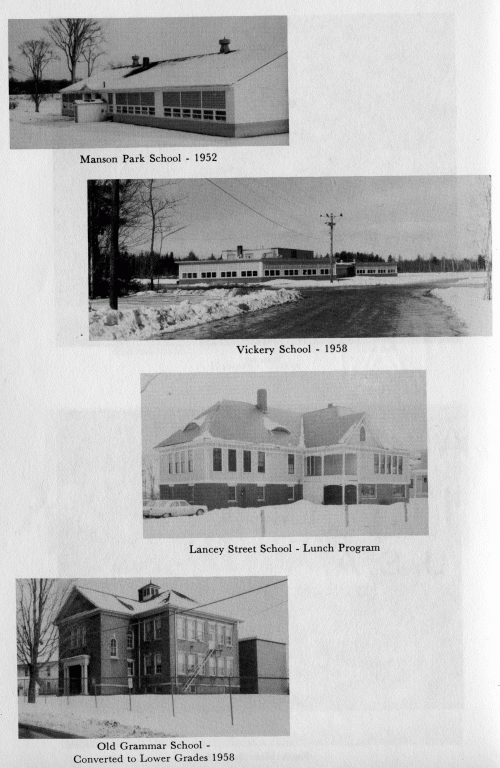
[Page 152.4]
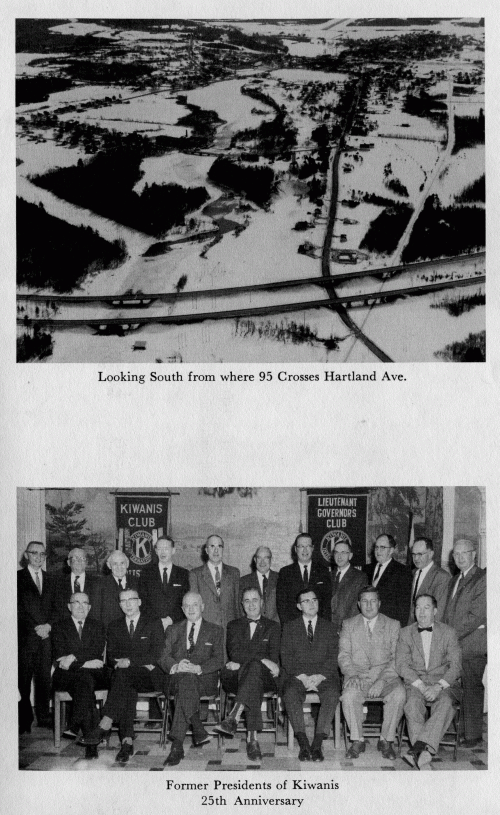
[Page 152.5]
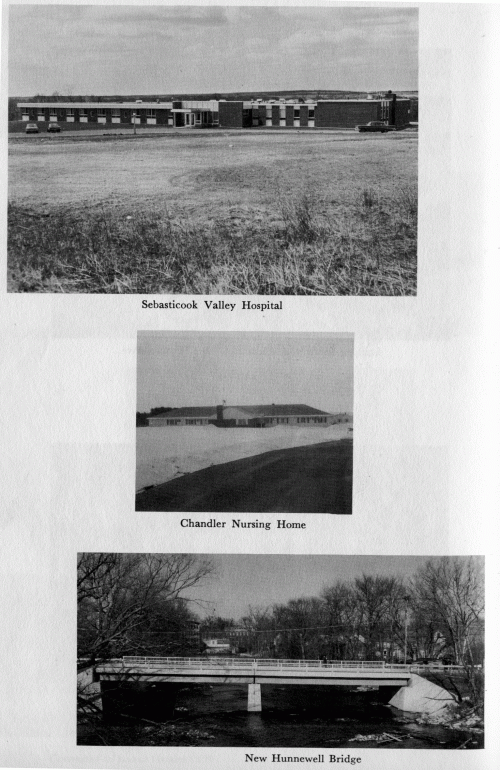
[Page 152.6]
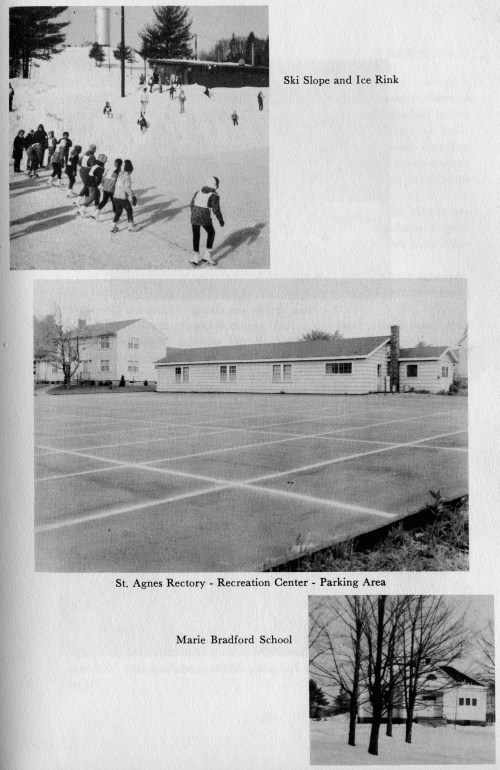
[Page 152.7]
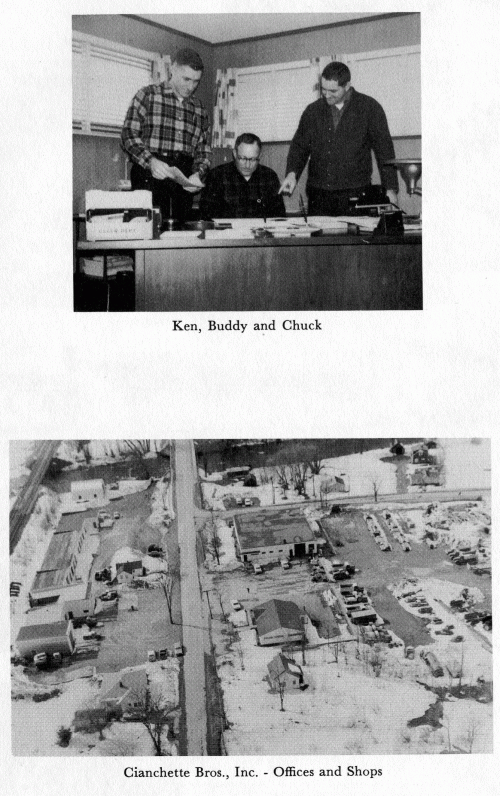
[Page 152.8]
by furnishing flags for their own stores. Thirty dozen flags were purchased by Kiwanis for Brownie, Girl, Boy, and Cub Scouts to wave as the President went by. Two huge pictures of Ike were framed under glass and displayed from the porch of the Lancey House by J. R. Cianchette. Town maintenance crews were busy all week cleaning streets over which President Eisenhower would pass, and home owners on the route dressed their residences appropriately. Frank Jacob’s fire department scoured their trucks to gleaming glory.
The response of the service organizations was terrific. At the request of James Doyle of Waterville, Department of Maine Legion Adjutant, about a dozen units converged on Pittsfield with their color guards.
The committee had been told that because of the tight schedule, the best we could hope for was the Presidents car might slow down, but could not stop.
There were those, knowing Ike’s inherent friendliness, who thought he might anyway. No one knew. Dulles last minute arrival in Bangor caused concern that the President might be in too much of a hurry to detour into Pittsfield at all.
An amplifying system kept the crowd of several thousand informed as to the progress of the President. A twoway radio contact by State Police was established to notify the officials when the entourage left Route 2 at Ell Hill.
The atmosphere crackled with expectation. Suddenly someone heard a siren. Cook frantically signalled to Bill Griffin who brought the band to an abrupt halt in the middle of a rousing march. False alarm—perhaps a police siren. We waited, and the band struck up again.
Suddenly all sirens in town broke loose—the big fire department siren, the police cars and fire trucks. The crowds cheered madly. Secret Service and State police cars bowled around the corner.
Here they come! Cook shouted on the mike. It was only the advance patrol going through to stop traffic at the towns north approach!
We were standing in front of the Lancey House. Suddenly a vast roar mushroomed up from Central Street. Cook shouted, Remember, this is President Eisenhower. He doesn’t come here every day!
153
And there he was!
The band immediately struck up Hail To The Chief.
We had heard about his bullet proof limousine; we expected to catch a glimpse of him sitting in his glass enclosure; that he would be wearing a conservative black or gray suit, hatted, dignified, perhaps carrying the aloofness of his office.
But in a flash, we learned that Ike’s exuberant informality and obvious delight at the reception were his lovable badge of dignity, not his wearing apparel. Hatless, wearing a natty, brown suit to complement his sportsman’s tan, he stood up and waved vigorously, his infectious grin captivating the hearts of everyone. He gave a military salute as he passed the color guards, and suddenly signaled the driver to stop.
He spoke a few words to Senator Smith, who sat beside him like a princess and started to fumble with the latch.
How do you get out of this thing, anyway? he asked.
Two S. S. men, walking beside the car, sprang to his assistance, and Ike stepped out onto the street, completely at ease as the crowd surged forward.
Everyone was dumbfounded. Even his guards were visibly upset. Their eyes like steel, were constantly roving back and forth over the crowd, alert for any suspicious move.
Cook boomed to the crowd, The President of the United States! and tremendous cheers and applause vaulted back and forth through the canyon of Main Street. Tears coursed down cheeks and someone said later, It made the back hairs stand right up on my neck!
Cook approached the President and held out the mike to one of the guards, hoping he would hold it for the President to say a few words. The guard shook his head.
Cook didn’t have long to be plagued by indecision, for Ike grabbed the mike from his hand and with a hearty laugh, said, Are there always so many people on the streets of Pittsfield?
Elbowed on each side by the guards, the President extended brief greetings and appreciation for the tremendous ovation, and wished all the people Good Luck.
I haven’t heard anyone who could repeat, word for word, the Presidents greeting, it all happened so fast. He was practically pushed
154
into the car by the S. S. men, and, as he was driven away, he stood up, cupped his hands to his mouth and shouted, “Thanks for the gifts!*rdquo;
The gifts were a package of Maine streamer flies tied by Wallace Cunningham, and three pairs of specially designed loafers from Northeast Shoe for his grandchildren. They were attractively giftwrapped by Rose Coldwell and placed on the bureau of his dressing room at Senator Smiths home.
After it was over, everyone felt that Ike had waved personally to him. He shouted, Hi Father! as he passed Rev. Lynch standing near the Catholic Rectory.
Ed Stanley stood near Hathorn Park with his young daughter in his arms to catch a glimpse of the President, admittedly impassive about the whole thing. I got so excited, I was jouncing Marcia up and down and almost threw her into Ikes car! he said.
Others said they got a lump in their throats; some almost cried; others were choked up; and the universal opinion was that it was a thrill of a life time.
It was indeed a thrill and a historic moment in the life of Pittsfield.
TOWN AFFAIRS
Local politics during this period, outside of school matters, did not produce any great excitement. One or two issues aroused the interest of the voters and in one instance resulted in constructive action. There was mild interest in a zoning ordinance, but the proposal for doing something about our water supply brought on considerable discussion, and after careful study, a $75,000 bond issue was authorized to replace the old wells and pumping station at Waverley Dam. A Massachusetts firm was hired to make tests for a new water supply and after several attempts along the esker bordering the Sebasticook, a location was discovered on lower Peltoma Avenue about a mile out of town that would produce sufficient and satisfactory water. A well was drilled and a pumping station constructed. It has been the consensus of the citizens that we now have as fine a supply of good quality water as can be found anywhere.
There were several changes in the town office during these twenty years. In 1941, C. R. Ames, who had served the town in many
155
capacities, was Town Manager. He resigned in 1946 and Ray Badger was appointed in his place. Mr. Badger occupied the position for 3½ years when he resigned to be replaced by Frank Keezer in December of 1949. Mr. Keezer, who had been associated with Ames Baldwin Company in Palmyra, proved to be a popular and efficient Manager. He died suddenly in 1953 and Allen M. Marks became Town Manager. In 1956, Mr. Marks moved to another position and O. Lionel Pomroy was appointed to the office. Although Mr. Pomroy had had no previous experience as a town manager, he was popular and capable. As the decade ended, he resigned to accept a more lucrative position with the city of Brewer.
As an indication of how smoothly town affairs were carried on during this period, we read that at the 1947 meeting 54 articles in the town warrant were taken care of in 55 minutes! It seems to be the rule that when times are good, politics are dull.
HEADLINE PERSONALITIES
There were many interesting personal items in the news during this period. Lloyd Stitham was elected County Attorney, but was unable to serve because of being called into the armed services. Later, he was reelected several times and ably served the county. Dr. M. A. Webber, first president of Kiwanis and the only president to hold the office for two terms, was honored by being chosen Lieutenant Governor of the Ninth District. Earl Banks in 1942 was elected Grand Patriarch of the Grand Encampment of Maine, and the same year Phillip Young, according to The Pittsfield Advertiser, became engaged to movie actress Dorothy McGuire. In 1945, Joe Shuman was honored by the War Production Board by being named a most cooperative dealer in scrap metal. Also in 1945, Aubrey B. Call resigned as caretaker of the cemeteries, thereby bringing to a close 77 years of consecutive service for the Call family.
In the professional field, there were several changes. Karl V. Anderson, M.D. came to Pittsfield in 1946, but shortly left to join the staff at the Veterans Administration at Togus; Ernest Stein, M. D. moved here from Stockton Springs in 1952, purchased the former S. R. Haines residence on Main Street, and has carried on an active practice. Warren G. Strout, M. D. opened an office for a short time and
156
then moved to Bangor to become a member of the Eastern Maine General staff. Stanley H. Short, D. D. S. practiced for a brief time and Elias R. Nawfel, D. D. S. opened his offices in the bank block. Robert Parker, Doctor of Optometry, opened an office at his home on Main Street in 1947. Marshall Gerrie, Doctor of Osteopathy, had his office at his home on Railroad Street and after a few years of successful practice moved to Waterville to become associated with the Osteopathic Hospital of that city. He served as president of Kiwanis in 1948. John Woodcock, D. V. M. located on Somerset Avenue in 1949 and served most of the area throughout Sebasticook Valley. Recently, he gave up his private practice to accept a position with the state.
Among the farmers, Halle Grant and Harry Dunton were in the news quite often because of their fine herds of dairy cows. Herbert Newhouse, after graduating from M.C.I., in 1923, joined his father in farming and in a very few years became one of the outstanding poultry producers of Maine. Twice in his farming career he has sold his poultry interests, but each time returned to build a larger and more modern plant. Following a spectacular fire in 1961 that destroyed his poultry house, he erected one of the largest and finest plants in the industry. After several years of successful operation, he sold the business to his son, George, who today is carrying on in the tradition of his father.
Mr. and Mrs. Ernest Vigue made a success of raising turkeys. They built a wholesale and retail business that became well known throughout the state. For awhile, they operated on the Halle Grant farm and then, following a fire, they built a modern establishment on Route 2. Since Mrs. Vigue’s death, Mr. Vigue has carried on the business alone.
During the 40s, Ralph Cianchette was appointed deputy sheriff, W. C. Francis was pitching the Pittsfield ball team to tri-county championships, Sally Friend became Miss Pittsfield and went on to become runnerup for Miss Maine. Roy Sinclair was elected president of the Maine Good Roads Association, Kilborn Merrill was getting his Boy Scouts ready for a big jamboree at Gettysburg, and Father Leo Carey, in 1948, was given a farewell testimonial at the Grange Hall as he left Pittsfield for Dover-Foxcroft.
Probably Mr. and Mrs. Lloyd Brooks have received more personal publicity than any other family in Pittsfield. Their remarkable
157
all girl family got nation wide attention as their twelfth and thirteenth child came along. Sponsored trips to New York, Life Magazine feature stories, and newspaper publicity made them nationally famous. The arrival of Leslie Benjamin in 1954 took the spotlight off their Snake Root Road home and allowed them to live a more normal life. Occasionally, however, as one of their pretty daughters becomes a bride, reminiscences are in order.
OBITUARIES
Many well known faces passed from the scene during these two decades. Among those were, in 1940, Frank Fairbanks, J. E. McMichael, Mrs. William Hunnewell, and Harry Condon. In 1941, E. D. Call, Russell Craig, J. W. Manson, E. N. Shaw, and J. N. Tarbell. 1942, Andrew Younger and Perley J. Whitten. 1943, Dr. F. H. Freeman, L. M. Knight, and David Manock. 1944, Earl Tucker, William McGilvery, Dorothy Drake Haseltine, and Charles H. Bussell. 1947, James Lagorio. 1948, Dr. William Cargill and Professor Landman, former Principal of M. C. I. 1954, Clayton Courser, Thomas A. Anderson, Royal Grover. 1956, Clarence Emery, former outstanding M. C. I. athlete, who died at his home in Dixfield. 1957, Charles R. Ames and Bernard Conroy.
Thus concludes a chapter which tells a story of unusual progress—resurgence in industry, in education, in spiritual life and in youth activities. Nearly every phase of our community life seemed to move ahead as a result of new thinking and new strength that characterized the early 40s. The momentum of that drive continued as we entered the 60s and a new generation accepted the responsibilities of leadership.
158
|